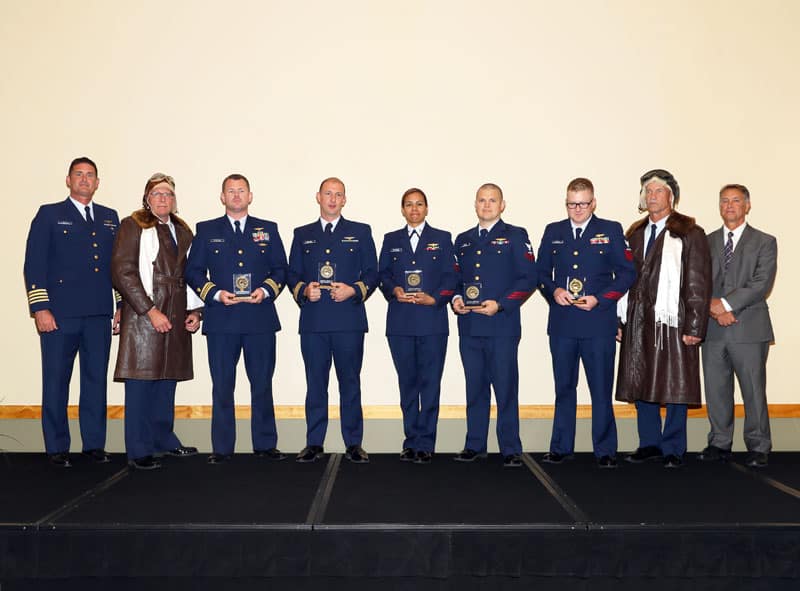The Captain Frank A. Erickson Rotary Wing Rescue Award is presented to the Air Station Kodiak crew of CGNR 6593, LCDR Daniel Schrader, LCDR Adam Mullins, AMT2 Jentzen Green, AET1 Gregory Mayes, and AET2 Jacqueline Gutierrez, in recognition of their heroic efforts from 04 MAY 2018 to 07 MAY 2018, responding to a critically ill crewmember aboard Naval Vessel SBX-1, 1000 nautical miles southwest of Dutch Harbor, Alaska. Deployed aboard USCGC JOHN MIDGETT, the crew of 6593 was tasked with executing a long-range MEDEVAC over 400 nautical miles from land.
The crew was immediately met with difficulties as they were forced to fly two sorties over a combined 120 nautical miles to embark all the necessary gear and crew onto CGC JOHN MIDGETT from Dutch Harbor, Alaska. The steadfast crew, already fatigued from a previously executed MEDEVAC early that morning, was forced to navigate through snow squalls and ¼ statute mile visibility to complete the re-embarkation aboard the cutter. As the 977 millibar low pressure system rapidly approached, along with the threat of higher winds and seas, the aircrew conducted extensive mission planning in preparation for the MEDEVAC. The crew made use of all available weather resources, gathered info on the patient’s condition, and stripped the aircraft of all non-essential equipment to allow for increased endurance. Taking advantage of a short lull between two weather systems, the crew of 6593 launched into 22 knot winds and 10 foot seas to fly 80 nautical miles to rendezvous with SBX-1. While enroute, the cutter suffered a turbine casualty forcing a reduced transit speed and increasing the distance for the aircrew’s return flight. To make matters worse, the aircrew began experiencing 70+ knots of wind with 3 statute miles of visibility and the decision was made to land on the Navy vessel to wait out the weather. After landing on SBX-1, and while being accosted by high winds while embarking the patient, the crew was informed that the Navy vessel did not have the necessary tie down gear to secure the helicopter until the weather passed. Unable to wait out the storm and with rapidly decreasing fuel, 6593 made the decision to fly back to CGC JOHN MIDGETT and attempt a landing. Flying at over 200 knots ground speed back to the cutter, the crew was soon met with 16 to 18 foot waves breaking over the bow of the ship. The cutter reported that they were at maximum pitch and roll limits with occasional pitching and rolling exceeding the slope landing limits of the airframe. Concerned about a roll-over on deck, the crew made the difficult decision to keep all tie down members off the flight deck for their safety. The aircrew astutely observed the movement of the ship and began their landing attempts. Thwarted twice, the crew remained firm in their resolve and their final attempt was met with success. After delivering the patient to the awaiting corpsmen and as seas grew to 26 feet, the crew began a lengthy 3-hour blade folding and heavy weather traversing evolution to shelter the helicopter in the hangar. After the helicopter was secured, the cutter transited 360 nautical miles towards Adak for the final leg of the mission. 6593 launched one last time at the edge of the cutter’s wind limitations and successfully transferred the patient to awaiting Emergency Medical Services.
